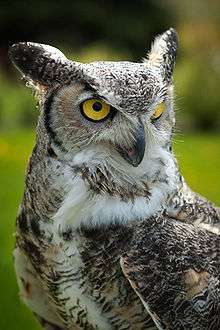Ear tuft
Ear tufts are skin projections covered in feathers found in some bird species, most notably various species of owl, vaguely resembling mammalian ears, but unrelated to the animal's hearing. Their function remains uncertain.

About
Theories about their function range from improved ability to camouflage,[1] aiding in finding a suitable mate,[2][3] to giving a more threatening appearance to discourage predators.[4]
In Araucana chicken
In the Araucana chicken breed, ear tufts are a mutation. It causes a skin projection covered in feathers to appear on the sides of the head near the ears. This mutation is dominant semi-lethal. Consequently, ear tufts are very unusual and difficult to breed, as most Araucanas are hatched without tufts.[5]
Lethal gene
Ear tufts in the Araucana breed of chicken are associated with a lethal gene: An ear tufted hen mated with an ear tufted cock produce chicks with deformed ears and mouth that die before hatching. Also, the rumplessness of the breed makes breeding Araucanas together have very short backs. In any other chicken breed, ear tufts are undesirable. [6]
References
- Perone, M. (1981). "Adaptive significance of ear tufts in owls". Condor. 83: 383–384. doi:10.2307/1367512.
- Sparks, J.; Soper, T. (1970). Owls: their natural and unnatural history. New York: Taplinger.
- Burton, J.A. (1973). Owls of the world: their evolution, structure and ecology. New York: Dutton.
- Mysterud, I.; Dunker, H. (1979). "Mammal ear mimicry: a hypothesis on the behavioural function of owl "horns"". Animal Behaviour. 27: 315. doi:10.1016/0003-3472(79)90158-1.
- "Araucanas by Alan Stanford, Ph.D from the June/July, 2007 issue of Backyard Poulty". Backyard Poultry. Retrieved 12 February 2013.
- The Chicken Encyclopedia by Gail Damerow, pg. 59